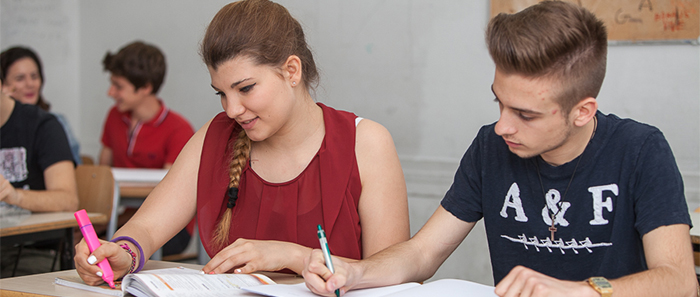Ready
The other day I was looking through some of my old school exercise books from the 1980s. I’d remembered how my teachers had insisted on neatness and order, titles and dates but I hadn’t appreciated the extent to which they regularly taught and expected us to set out notes in a particular way.
Mr Chambers was my first Latin teacher. He had the best handwriting I’ve ever seen and was particularly rigorous about how we copied down what we learnt. I’m sure the close attention he paid to what I was doing helped me to remember my noun and adjective endings, and helped me to achieve the top grade at A Level some seven years later.
Mr Poole, one of my Geography teachers, was also keen on attention to detail, liking hand-drawn maps and labels being clear and correct. During every lesson he told us to pack our bags the night before rather than rushing and forgetting our books and homework in the morning. I often remember his words as I prepare myself for the next day.
Mr Poole and Mr Chambers were, in their own way, clearing distractions and creating the conditions for learning to take place, helping put everything in its right place.
Steady
These days I’m still eager to be prepared and avoid unnecessary distractions as I juggle professional and personal priorities. As such, I was comforted when I read the work of Daniel Levitin, Professor of Psychology, Behavioural Science and Music at McGill University in Montreal. In his award-winning book, The Organized Mind: Thinking in the Age of Information Overload (Dutton/Penguin 2014), he sets out the research and gives plenty of practical advice.
Here are five highlights for both teachers and students.
- Multi-tasking is a myth. Our brains operate at 120 bits/second. If we are having a basic conversation with someone else, half of our brain’s ”bandwidth” is already being used. Instead of multi-tasking, we are in fact switching our attention from one thing to another. This also explains why it is next to impossible to concentrate on something else when an animated conversation is taking place nearby.
- Chunk things up. As adults we are more able to sit still for long periods, read lengthy texts or plan more complex projects. This is partly because we have learnt how to break things down into smaller parts while still seeing the bigger picture. We have discovered how things that are large are often more manageable and more motivating to deal with when they are divided into pieces with clear beginnings and endings.
- A bad workman blames his tools. Those who are well organised have established routines to work through problems; quickly evaluating information and finding solutions. With the right tools (and knowledge of how to use them) we can focus, avoid wasting time and get on with what’s important.
- Creativity works best within constraints. A good example of this is how composers work within systems of notation or chemists use the periodic table. Given a template to work with or a set of rules, we often find it easier to get started and be innovative. Freed from distractions, we are more likely to get into a creative flow.
- It is important to allow our minds to wander. This helps our brains re-calibrate and restore as we simply don’t have enough energy to focus and concentrate 24 hours a day. It is also useful to ‘sleep on it’. Overnight our minds recharge and our brains make new connections. This is particularly true for things we engage actively with and care about.
I have previously blogged about Doug Lemov’s Teach Like A Champion, in which he sets out a number of techniques to help students be ‘college ready’. He also writes about the importance of creating the right conditions for learning to take place:
- In his technique #10 ‘Double Plan’, he says it is as important to plan for what your students will be doing during each phase of your lesson as it is to plan for what you’ll be doing and saying. Some teachers may know this as T-Planning, where you write in one column what are doing as a teacher and alongside it in another column what students will be doing.
- In #14 ‘Board = Paper’, Lemov advocates helping students learn to take notes and retain a record of knowledge. Most students don’t have any idea what the key things to copy down are or how to set them out unless they are told.
- In #31 ‘Binder Control’, we are advised to help students organise their papers, for example by numbering sheets and sections. This helps our students learn how to classify their materials, prepares them for revision, and helps us to check they have all that they need.
- In #33 ‘On Your Mark’, the goal is to set expectations for students to be ready at the beginning of each class. Students soon learn that an empty or messy desk is not good enough. Instead they have their paper out, pencil sharp, homework on display, and nothing more.
- In #37, ‘What To Do’, Lemov explains the importance of specific, concrete, sequential and observable directions. Rather than criticising students for not knowing how to behave, we sometimes need to look at ourselves and check that we have been clear and reasonable in our expectations.
Go
At the beginning of his book, Professor Levitin explains that in a world of digital distractions, and competing personal and professional demands, we have to put up with ‘satisficing’ – ”deciding on and pursuing a course of action that will satisfy the minimum requirements necessary to achieve a particular goal”- a term first introduced by the Nobel Prize-winning economist Herbert A Simon in 1956. As teachers we need to do all we can to help our students do more than this while being aware of cognitive limitations.
Levitin proclaims that, ”Getting organised can bring us all to the next level in our lives”, and I would tend to agree. Without my Gibsonian affordances, routines and techniques, I would struggle to manage all that I have to do. I understand the value of having everything in its right place so that I can be chaotic and messy when I need to be too!





